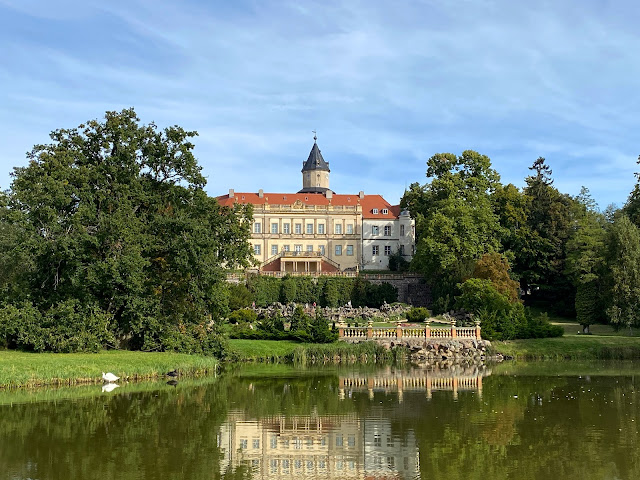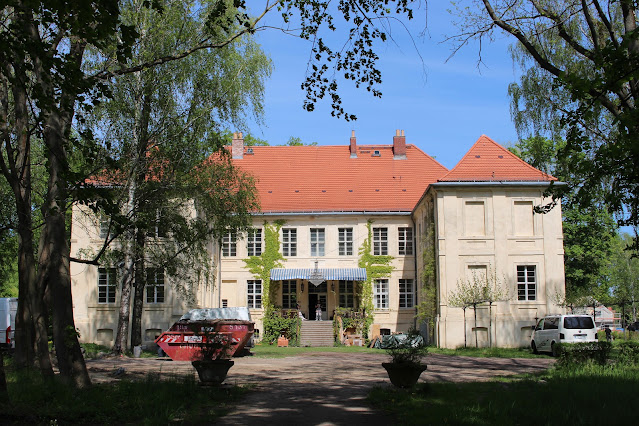Beyond Potsdam: Eleven Castles in Brandenburg to Visit Off the Beaten Path
From the Prussian palaces of Potsdam to plentiful noble homes scattered all around the state, we have probably covered dozens and a dozen more of castles located in Brandenburg, the German state surrounding Berlin. (Find all of them here.) But still, there are a gazillion more to discover, so here are ten castles you have probably never heard of. Most of them actually aren't open to the public yet many of them have surrounding parks you can stroll through. How I visit them? These sorts of castles usually aren't the main destination of my days out castle hunting. I either see them on the way to or back from places open to the public or I try to include them in a hike.
Schloss Wiesenburg
Schloss Wiesenburg may just be the most idyllically located of all idyllically located castles on this list. Looking over a large park, its origins date back to the Middle Ages when a fortified castle was located on the same site. The oldest parts of today's Renaissance-style Schloss date back to the 16th century with a major Neo-Renaissance remodelling taking place during the 1860's according to plans by Oskar Mothes. At the time, it was owned by German politician Curt von Watzdorf. Over the last few years, Schloss Wiesenburg became an apartment building.
Burg Eisenhardt
While the hike that first led me to Schloss Wiesenburg started at said train station nearby, it ended with another castle in Bad Belzig. Burg Eisenhardt was firstly mentioned over a thousand years ago in 997 though its current name only dates back to the 15th century. During its long history, a great many famous people stayed at the castle including Martin Luther and Russian tsar Peter I.
Schloss Meseberg
Schloss Meseberg and its perfectly manicured trees are a regular feature in Germany's evening news. Why? The Baroque palace north of Berlin is the retreat of the Chancellor of Germany and the official state guest house of the German Federal Government. Built by the Wartensleben family, the Schloss was at one point in history owned by Prince Heinrich of Prussia, brother of Friedrich II, who gifted it to Christian Ludwig von Kaphengst. The property was later purchased by the Lessing family, who were the owners of a publishing company. During the Nazi era, it was forcibly acquired by Hermann Göring and later appropriated by the Soviet occupation in 1945. It is currently owned by the Messerschmidt Foundation who leases it to the German government.
Schloss Altranft
As early as the 16th century, the von Pfuel family owned the estate Schloss Altranft is situated on. Originally, it was a rather simple manor house that was repeatedly converted and extended over the centuries. The building was transformed into its current shape in 1876 when Count Erwin Carl Wilhelm von Hacke called it his home. Owned by the state of Brandenburg, it houses a museum dedicated to agriculture and the local area.
Schloss Sommerswalde
Not all palaces were built as noble homes, case in point: Schloss Sommerswalde. Its construction fulfilled the lifelong dream of the Berlin bourgeois Richard Sommer. He financed the building with the sale of family-owned land around the Brandenburg Gate and commissioned architects Hans Abesser und Jürgen Kröger. The plans for Schloss Sommerswalde were actually heavily inspired by Paul Wallots first but never realised plans for the construction of the German parliamentary building, the Reichstag, though in much smaller scale.
Schloss Schwante
Schloss Schwante was built from 1741 to 1743 by the landowner Erasmus Wilhelm von Redern and his wife Catherina Elisabeth von Bredow by an unknown architect, probably under the advice of Georg Wenzeslaus von Knobelsdorff, the man behind most of Prussia's palaces. For a few years during the early 20th century, Richard Sommer also owned this estate as one palace apparently wasn't quite enough for him. These days, you will find permanent art installations in its park.
Schloss Ziethen
Today a hotel, the origins of Schloss Ziethen date back to at least the 14th century when it was owned by the von Bredow family. The Medieval buildings were destroyed during the Thirty Years' War and the reconstruction used to extend and raise it with a remodelling the Baroque style. In the late 19th century, the Baroque manor house was extended by the two striking side wings in the Neoclassical style. These days, its owned again by descendants of the old Prussian von Bredow family.
Schloss Wansdorf
Owned by different noble families throughout the centuries, the so-called Neues Schloss, or New Palace, in Wansdorf is an Art Nouveau villa built around 1900 by industrialist Ferdinand Griebenow though he never lived there. His widow sold the small palace to the city of Spandau. It was later used as a rehabilitation clinic and as an educational institution for teachers. Currently is is privately owned and you can only admire it from the street.
Schloss Marquardt
Situated on the shores of Schlänitzsee near Potsdam, Schloss Marquardt today is primarily famous as a film set. With its history dating back a lot further, it was in the year 1879 when the then owner of the castle, Carl Meyer, representative of the Essen-based Krupp company in Berlin, had Schloss Marquardt rebuilt as a two-storey building. After it was sold to the steel merchant Dr. Louis Ravené, it was given its present appearance by means of an extension and the addition of another storey. The Kempinski hotel group leased the property in 1932, establishing it as a popular destination for people from nearby Berlin.
Guthaus Köpernitz
Not strictly speaking called a castle or palace but a manor house, the Gutshaus Köpernitz was another estate owned by the von Bredow family. The village by the same name was firstly mentioned during the 15th century. Many years later, a water mill, an outlying estate and a sheep farm were built there by Jobst von Bredow. The Gutshaus received its current architectural appearance some time around the turn of the 20th century.
Schloss Freienwalde
Last but certainly not least is a palace you can actually visit: Schloss Freienwalde in, you guessed it, Freienwalde. Originally built in the very late 18th century as a widow's seat for Queen Friederike Luise of Prussia according to plans by David Gilly, its most famous inhabitant was probably Walther Rathenau. The German industrialist, writer and liberal politician purchased the palace from the Prussian crown in 1909. Rathenau served as German Foreign Minister in the early 1920's until his assassination by a right-wing paramilitary group. Schloss Freienwalde today houses a museum in his memory.













